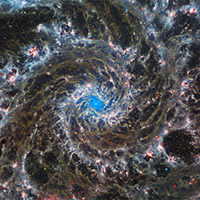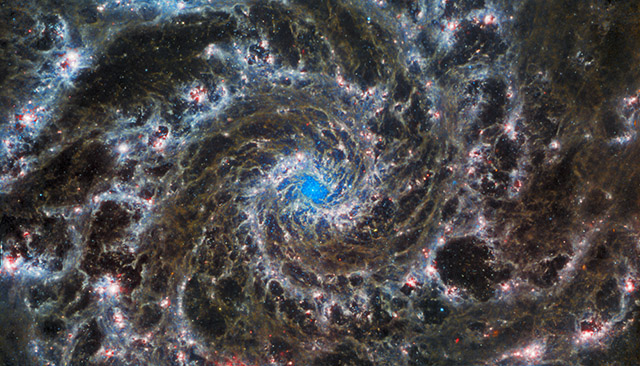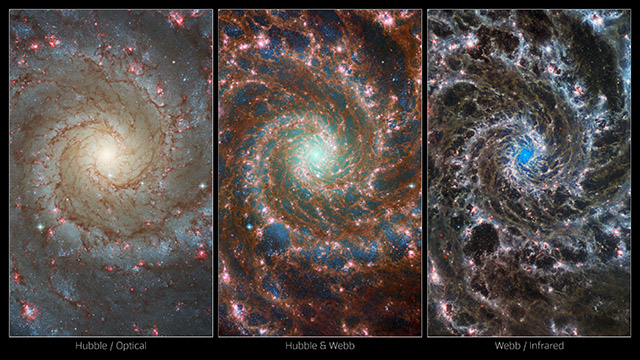Webb captures stunning view of the Phantom Galaxy
posted Wednesday, August 31, 2022 at 4:15 PM EDT

The James Webb Space Telescope recently used its Mid-Infrared Instrument (MIRI) to look at the heart of Messier 74, also known as NGC 628 or the Phantom Galaxy. MIRI resolved the spiral galaxy in exceptional detail.
The Phantom Galaxy is around 32 million light-years from Earth in the constellation Pisces. The galaxy contains a pair of clearly defined spiral arms and is considered an archetype of a grand design spiral galaxy.
While M74 has never looked better, we've known about it since 1780, when French astronomer Pierre Méchain discovered it before Charles Messier included it in his illustrious catalog.

Credits: ESA/Webb, NASA & CSA, J. Lee and the PHANGS-JWST Team. Acknowledgment: J. Schmid.
Click here for the full-resolution version.
Webb observed M74 "in order to learn more about the earliest phases of star formation in the local Universe." The Phantom Galaxy observations are part of a larger project to chart 19 nearby star-forming galaxies in the infrared spectrum. The project is spearheaded by the PHANGS collaboration. The targets, including M74, have been observed by Hubble (https://esahubble.org/images/potw2235a/) and ground-based observatories before. Still, Webb's high-resolution observations "will allow astronomers to pinpoint star-forming regions in the galaxies, accurately measure the masses and ages of star clusters, and gain insights into the nature of the small grains of dust drifting in interstellar space."

Click here for the full-resolution version.
In the video below, we see into the heart of M74 with MIRI. ESA writes, "Webb’s sharp vision has revealed delicate filaments of gas and dust in the grandiose spiral arms which wind outwards from the center of this image. A lack of gas in the nuclear region also provides an unobscured view of the nuclear star cluster at the galaxy's center."
This next video shows how Hubble's observations compare against Webb's. Hubble shows older, redder stars toward the galaxy's center and younger, bluer stars as you move toward the spiral arms. Webb's image is much different, highlighting gas and dust within the galactical arms and showing denser clusters of stars.
Finally, we can see what M74 looks like when combining Hubble and Webb's observations. ESA writes, "With Hubble’s venerable Advanced Camera for Surveys (ACS) and Webb’s powerful Mid-InfraRed Instrument (MIRI) capturing a range of wavelengths, this new image has remarkable depth. The red colors mark dust threaded through the arms of the galaxy, lighter oranges being areas of hotter dust. The young stars throughout the arms and the nuclear core are picked out in blue. Heavier, older stars towards the galaxy’s center are shown in cyan and green, projecting a spooky glow from the core of the Phantom Galaxy. Bubbles of star formation are also visible in pink across the arms. Such a variety of galactic features is rare to see in a single image."
While Webb is all the rage these days, and with good reason, it's important to realize how different observations combine and complement each other. Observing celestial objects across a wider electromagnetic spectrum reveals critical details and furthers our collective understanding.